How Colorado plans to curb accidental pot consumption
Loading...
Sweets-lovers in Colorado will no longer need to give their brownie a double take before consuming.
Beginning Saturday, all medical and retail marijuana products must feature a universal symbol.
A diamond shape featuring “THC,” the acronym for the active ingredient tetrahydrocannabinol, will now appear on both the packaging and the edible item itself. The phrase, “Contains Marijuana. Keep out of reach of children,” will also be clearly labeled below the symbol.
Along with the newly required symbol and warning, the words “candy” or “candies” are prohibited from appearing on packaging of marijuana-laced products. Each product must also include a potency statement as well as the appropriate serving size.
“With the new universal symbol, people can more easily identify marijuana products, monitor their intake by serving size and avoid eating too much,” Larry Wolk, executive director and chief medical officer at the Colorado Department of Public Health and Environment, said in a press release. “And by making marijuana labels less appealing to children, we hope to keep them from accidentally eating THC and suffering the consequences.”
The number of incidents oaccidentalal marijuana consumption by children has increased since Colorado legalized the drug in 2014. In 2009, before the drug was legalized, only nine calls were made to local poison control centers regarding accidental marijuana consumption. But by 2015, the number of these calls increased to 47.
“From the beginning of recreational sales of marijuana in Colorado, stories started trickling in about both children and adults ending up in emergency rooms after eating treats laced with it,” The Christian Science Monitor’s Amanda Paulson reported last year. “The popularity of ‘edibles’ – the various candies, chocolates, and baked goods that contain cannabis – took many Coloradans by surprise. So did the problems that came with it.”
In February 2015, the state health department recommended a ban on all edibles, but the idea faced harsh pushback from consumers and the industry, as edibles make up roughly one-third of all marijuana-related sales. Instead, the health department issued a series of rules for the packaging and potency of edibles, which have been made stricter and more detailed yet again with the new regulations.
“We want to ensure that people genuinely know the difference between a Duncan Hines brownie and a marijuana brownie, just by looking at it,” says state Rep. Jonathan Singer, a Democrat who sponsored the new law.
However, some dispensary and pot shop owners are miffed by the new regulations. During hearings before the regulation, some distributors compared the new regulations to requiring all alcohol makers to dye their products strange colors for precautionary measures.
“Some of the industry expectation was, ‘Let’s keep it on the parents and the users in keeping it away from children or people who shouldn’t use it,’ ” says Andrew Schrot, owner of BlueKudu, a company that makes marijuana-infused chocolate. “But you know, sometimes mistakes happen. You turn your back and a product is left out.”
Retailers have until Dec. 1 to phase out stock that does not include the new symbols.
This report contains material from the Associated Press.








